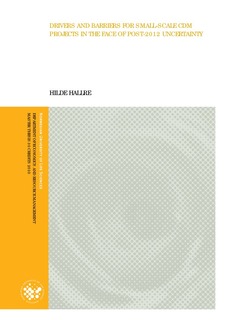| dc.contributor.author | Hallre, Hilde | |
| dc.date.accessioned | 2011-04-29T12:08:01Z | |
| dc.date.available | 2011-04-29T12:08:01Z | |
| dc.date.copyright | 2010 | |
| dc.date.issued | 2011-04-29T12:08:01Z | |
| dc.identifier.uri | http://hdl.handle.net/11250/187193 | |
| dc.description.abstract | The Clean Development Mechanism (CDM) was introduced as part of the Kyoto Protocol to provide industrialised countries with more low cost ways to meet their GHG emission reductions. It has the dual objective through also aiming to contribute to sustainable development in developing countries.
Small-scale projects have been given a simplified procedure for the CDM process in an attempt to encourage such project. One of the main barriers has been high transaction costs that are not as easily absorbed for small projects, and the simplified process was intended to reduce this. However, recent data indicates that the cost and timeframe connected to clearing the CDM project cycle has increased, and even more so for small-scale projects.
In addition to this the approaching expiry of the Kyoto Protocol leads to uncertainty with respect to the future of the carbon market. Despite predictions of a drop in project applications for the CDM pipeline, there are still projects going in. This thesis focuses on the 6 technologies that have most activity with respect to small-scale projects. These projects do not appear to have any clear characteristics, however some patterns emerge within the different technology categories.
For several of the technologies there appear to be some national drivers behind the applications. India and China are the two dominating host countries for CDM projects, however they are dominant in different technologies. They also differ in that India has a high level of unilateral projects, whereas China hardly has any.
The complexity and subjectivity of the CDM process creates uncertainty for project developers. The decisions of the Executive Board (EB) appear to influence what type of projects that enter the pipeline. A streamlining of the process appears necessary to ensure the integrity of the CDM. | en_US |
| dc.language.iso | eng | en_US |
| dc.publisher | Norwegian University of Life Sciences, Ås | |
| dc.subject | CDM | en_US |
| dc.subject | Clean Development Mechanism | en_US |
| dc.subject | Small-scale projects | en_US |
| dc.subject | technologies | en_US |
| dc.subject | hydro power | en_US |
| dc.subject | biomass | en_US |
| dc.subject | biogas | en_US |
| dc.subject | wind power | en_US |
| dc.subject | solar PV | en_US |
| dc.subject | drivers | en_US |
| dc.title | Drivers and barriers for small-scale projects in the face of post-2012 uncertainty | en_US |
| dc.type | Master thesis | en_US |
| dc.subject.nsi | VDP::Technology: 500::Environmental engineering: 610 | en_US |
| dc.subject.nsi | VDP::Technology: 500::Electrotechnical disciplines: 540::Electrical power engineering: 542 | en_US |
| dc.source.pagenumber | 73 | en_US |
